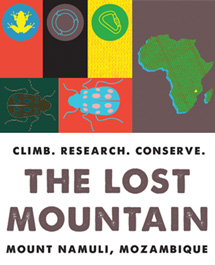
Mt. Namuli is one of a chain of inselbergs—literally “island mountains”—that rises abruptly out of the plains of northern Mozambique and southern Malawi. Inselbergs are island ecosystems that harbor extraordinary biodiversity and unique life. Each of the few scientific expeditions that have accessed these mountains has resulted in the identification of new species.
The Lost Mountain scientists will conduct entomological (insects) and herpetological (reptiles and amphibians) surveys of Mt. Namuli’s 2,000-foot granite cliff face, surrounding grasslands, and rainforest.
Objectives include:
- First-ever herpetological and entomological study of granite face; additional studies of grasslands and rainforest.
- Build new knowledge base of Mt. Namuli that will have impact on global biodiversity, conservation, and our understanding of evolutionary processes.
- Exploration of untouched cliffside habitat, including vegetated ledges, cracks, and overhangs.
- Identification of the King Dwarf Gecko that has been observed on the cliff, but not yet collected or described, and is believed to be unique to Mt. Namuli and a new species to science.
- Identification of a new species of frog and skink, both of which have been observed along the bast of Mt. Namuli, but not yet collected or described.
- Search for ants and beetles on the granite rock face, which if found, will likely constitute new species to science.
- These discoveries are vital for understanding the biogeographical links among the Mozambican and Malawian inselbergs and protecting southeast Africa’s dwindling wildlands.
The Lost Mountain Science Team is led by Flavia Esteves (California Academy of Sciences, USA) and includes Harith Farooq (Lúrio University, Mozambique) and Caswell Munyai (University of Venda, South Africa). Photos and bios at About the Team.


